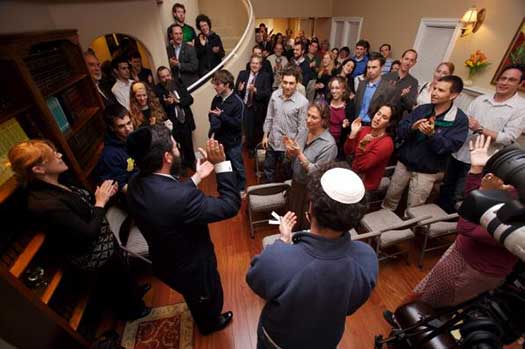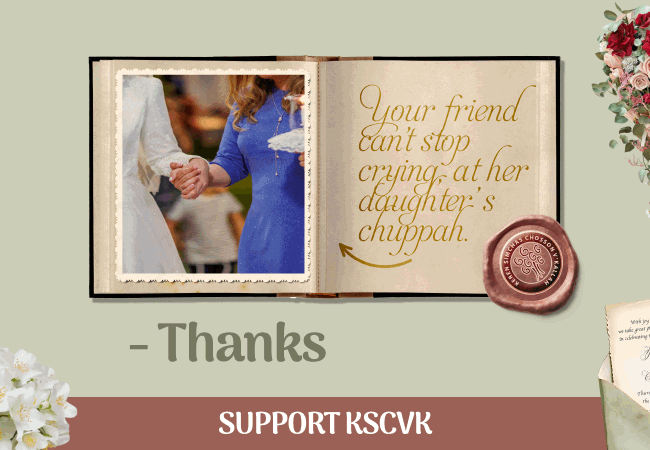
A Transformative Experience for Students at Stanford Chabad
Students biking through Stanford’s White Plaza several weeks ago back-pedaled curiously to check out an unusual scene. Set up at the center of Stanford’s campus was a Google Glass tefillin stand.
Still in development, Google Glass is not available to the public yet, and the Chabad rabbi, Rabbi Dov Greenberg, offering students the chance to try it, wasn’t telling how he got a hold of it. But they were fascinated, and some who had never put on tefillin before found the opportunity to do so in a technologically innovative way compelling.
Gideon Weiler, a Stanford sophomore studying symbolic systems, had to see this for himself. “I got an email from Stanford Chabad calling on students to come out and try this really cool project, an app for the tefillin blessings using Google Glass.
“It was the coolest thing in the world,” said the inter-disciplinarian major who is combining computer science, math, philosophy and economics. “Rabbi Dov was using absolutely the most cutting edge technology for one of the most ancient and fundamental practices that we have as Jews.”
Chabad’s Google Glass idea went viral. “It caught my attention because a rabbi was using geek marketing to attract Jewish students at Stanford back to the Jewish faith,” wrote Barry Schwartz in Search Engine Roundtable.
A breeding ground for Silicon Valley innovation, an incubator for techies launching new startups at a dizzying pace, and for geeks developing apps that change the way we live day by day, Stanford University’s hi-tech environment can be intimidating.
But the Chabad rabbi thrives on the university’s hypermodern culture. He’s comfortable with the terrain and knows how to employ it in the service of a timeless tradition. “Often at the Shabbat table, Rabbi Dov talks about how to integrate all of this into Jewish life,” said Gideon, who is also the financial officer of Stanford Chabad.
Dov and his wife Rachel—described by Gideon as “the taskmaster who makes it all happen”— have been serving Stanford’s Jewish students since 2002. In 2007, with a grant from The Rohr Family Foundation and the support of philanthropist Ted Taube, President of the Koret Foundation, they bought and renovated a property close to campus.
Hypermodern Culture In the Service of Tradition
The couple seems a perfect fit for Stanford, where students are drawn to the Torah study opportunities and the stimulating conversations at Chabad that challenge them to explore their Jewish identity from perspectives new and relevant. Of Stanford’s 1,6000 students, about 13 percent are Jewish. About half of the university’s Jewish student body regularly participates in Chabad’s educational and social activities at some time in the course of the year.
Dov has observed a pattern. “Many Jews in America today have an elementary Jewish education. When Jewish students come to Stanford, they compare the intellectually sophisticated education they are getting here to a juvenile Judaism, because they only have a third-grade level of Jewish education to refer back to. This is like the encounter between David and Goliath, but David doesn’t have the slingshot, so he loses.”
The rabbi’s goal is “to open the doors of Judaism to every Jewish student, and give them access to the depth and grandeur of our tradition.” Towards that objective, he leads an impressive array of classes, among them Jewish business, medical and law ethics classes at Stanford’s respective schools; Talmud and Jewish mysticism classes, a Sinai Scholars program, and other classes on a wide gamut of themes from the History of the Jews to A Skeptic’s Guide to Judaism.
Chabad’s Shabbat experience is an important element in the students’ Jewish experience. Dov and Rachel invest considerable energy to maximize the opportunity, and over the last five years Shabbat with Chabad has evolved into the largest single weekly Jewish event for the Stanford campus community, with attendance sometimes topping off at 150.
“This is a different pedagogical experience than the one offered to students in university classrooms,” says Rachel. “Here students are allowed to freely and comfortably interact with a supportive Jewish environment, often coming into extended-family like conversations with prominent Jewish mentors who are leaders in their respective fields and have the ability to inspire students towards a deeper appreciation of their Jewish identity, and commitment to Israel.”
Shabbat at Stanford Law School
When I attended a Shabbat dinner hosted by Chabad at Stanford’s law school one Friday evening in May, Rabbi Greenberg wasn’t talking technology. Most of the 100 students attending were graduating law students. Over an elegant three-course meal, I watched students delight in the spirit of Shabbat.
Apropos to the setting, the Chabad rabbi shared a Talmudic account about the life of Rabbi Yochanan ben Zakkai, the first century leading Jewish sage in the Second Temple era. He spoke of Rabbi Yochanan’s request that the Roman Emperor save Yavneh, the new home of the Sanhedrin, the Jewish Supreme Court and its sages, as Jerusalem and the Holy Temple were under siege and would soon be destroyed.
“Rabbi Yochanan might have asked to save the spiritual center of the Jewish people,” Dov told the law school graduates. “But he understood that more than that, Jewish law would be critical to the survival of the Jewish people. Indeed, Yavneh went on to become the center of Jewish law and scholarship for many years, and to this day, the corpus of Talmudic literature which emanated from there represents the Jewish intellectual tradition which sustains our people.”
Ohad Barak, a geophysics graduate student who grew up in a profoundly secular home, is a frequent participant with his wife Sylvie, at Chabad events.
“I may not agree with Dov on everything,” he said, “but he’s taught me many new, interesting ideas in terms of Judaism’s values, how they relate to my personal life, and to society as a whole. I think he is an amazing role model, and his intellectual abilities make him so well suited to Stanford.”
Visiting Professor Burt Neuborne and his wife participated at the Shabbat dinner. The nationally renowned civil liberties defender, former National Legal Director of the ACLU) urged the students to protest the academic boycott against Israel. Several weeks earlier, Condoleeza Rice joined 150 students at Shabbat dinner with Chabad on campus. “She interacted with the students for three hours,” Rachel said, “but she was especially impressed with the vibrant Jewish community that Chabad has nurtured at Stanford.”
Ultimately, says Dov, “students embrace Judaism each at their own level and pace, one mitzvah at a time. Some go kosher. We make many Jewish marriages among them every year. And many make Shabbat a part of their lives.
“Shabbat is the best institution in the 21st century that I know of that bring that brings family, community, and loved ones together. Relationships take time and Shabbat gives us that time. Students experience it and often say, ‘I want this in my life.’”
Chabad Connects Generations to Judaism
Professor Amichai Magen, Head of Political Development at the International Institute for Counter Terrorism (ICT), is a close friend of the Greenbergs. But when he was studying for his Ph.D in law, he didn’t think the Chabad rabbi had anything to offer him. Indeed, when he bumped into Rabbi Dov, he was prepared to give him attitude and a dose of Israeli cynicism.
“I was born and raised in the Zionist, socialist heartland in Israel’s Jezreel Valley.” Kibbutz Beit Ha-Emek was not only secular, Magen said in recent phone interview from Israel, where he teaches international law and international relations at Israel’s prestigious IDC. “It repudiated religion.”
In a way, Magen was typical of Israelis who grow up feeling antipathy towards religion in Israel. But he found Dov’s warmth disarming, his deep intelligence engaging. The stereotype he harbored began to melt away. Magen treaded gingerly at first, but over a period of six years, he grew close and grateful for Dov’s friendship.
“Chabad has changed me in profound and wonderful ways,” Magen, who is also a fellow at the Hoover Institute, offered. “Dov and Rachel have made a lifelong commitment to students at Stanford. And what they offer is a life transforming experience that connects them, their children and hopefully their children’s children to Judaism.”















